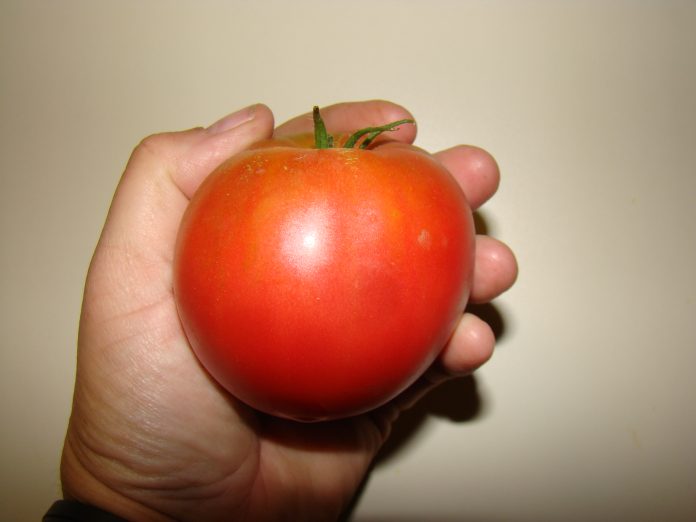Jackie Bantle
Saskatchewan Perennial Society
The wild tomato, Solanum lycopersicoides, originates in the Andes mountains of Peru and Chile. There are no historical records of it ever being eaten in this area. The tomato travelled north 2000 miles to central America (Belize) where the pre-Mayan people domesticated the wild tomato.
Hernán Cortés and his explorers are credited with finding the tomato in an Aztec market around 1520 and transporting the seed to Spain. From there, the tomato traveled throughout Europe and across the channel to England. Being a member of the nightshade family –the tomato was thought to be poisonous and initially was only used for ornamental value in Europe.
The fruit is not poisonous however, the leaves, stems and roots of the tomato contain solanine, a neurotoxin, and should not be eaten. Because the tomato was mistakenly considered to be poisonous by many, it was referred to as the “poison apple.”
Other names for the tomato included: wolf peach, gold apple and love apple (‘pomme d’amour’ in France because it was thought to be an aphrodisiac.
Interestingly, in the 1600’s, some upper-class Europeans DID die after consuming tomatoes, however, the fault was not with the tomato but with the pewter dinnerware used. The high level of acidity in tomatoes leached lead from the pewter, and those wealthy enough to afford to dine on pewter dinnerware died from lead poisoning after consuming tomato-based dishes.
It wasn’t until the early 1900s that tomato popularity became widespread throughout the United States. Today, tomatoes are the most popular vegetable in the world: 182 million tonnes produced globally in 2017 and over 10,000 different varieties are grown.
There is a huge variation between tomato plants and fruit types. Following are some of the more common types and their characteristics.
Cherry tomatoes – range in size from a thumb tip to a golf ball size. Cherry tomatoes are also known as grape tomatoes, currant tomatoes (small), or saladette tomatoes. Cherry tomato colors range from yellow, orange red, pink to purplish black. Cherry tomatoes are best used for fresh eating – snacks.
Paste tomatoes (also called Roma or Plum tomatoes) are egg-shaped (like a plum) and about 4-5cm wide and 6-7cm long. Paste tomatoes have thick fruit walls, meaty interiors and are used for sauces and cooking.
Standard tomatoes are those that are used for slicing on your sandwiches or quarters in your salad. They can be round or flattened and 6-7cm wide. Beefsteak tomatoes are a very large standard tomato type that is usually slightly flattened and are more than 7cm wide.
A tomato plant can have one of two different growth habits. It can be determinate or indeterminate. Determinate tomato plants are usually recommended for areas that have shorter growing seasons. Plants will only grow to a certain size, set fruit and all fruit will ripen over a 2-3 week period. The determinate tomatoes are bush type plants and do not need to be pruned. For successful fruit production every year in Saskatchewan, choose cultivars that ripen in 75 days or less.
Indeterminate tomato plants never stop growing. They are a vine type of tomato and need to be staked and pruned for the best tomato fruit production. Indeterminate plants can easily be 90-180cm tall and they will continue to flower up until frost. The tomato fruit on indeterminate plants ripens over a much longer time period so that you have an extended harvest period but not a lot of tomatoes all at once. For successful tomato production in every Saskatchewan growing season, choose indeterminate tomato cultivars that ripen in 65 days or less. In especially warm seasons and long growing seasons, you can definitely harvest tomatoes from indeterminate plants that take longer than 65 days to mature. Many cherry types are indeterminate.
If I have an excellent tomato, can I save the seed to grow the same tomato next year? The answer to this question depends on what type of tomato you are growing. If you are growing a hybrid tomato, the answer is ‘no’, you probably won’t get the same tomato as the one that you saved the seed from. If the tomato is an heirloom types and ‘open pollinated’ then, ‘yes’ you probably will get the same tomato from the seed you saved.
Tomatoes are self-pollinating: their flowers contain both male and female parts. Hybrid tomatoes are created when plant breeders intentionally cross-pollinate two different varieties of a plant, with the outcome being an offspring, or hybrid that contains the best traits of each of the parents.
Heirloom tomatoes are open-pollinated with a non-hybrid tomato cultivar. The DNA from heirloom tomatoes is stable and seeds from heirloom cultivars breed true to type. Heirloom cultivars are generally sweeter in flavour since they lack the genetic mutation that give the tomatoes their uniform red color (at the expense of their flavour). This is why heirloom tomatoes are generally more colorful than hybrid tomatoes.
I hope you are having an excellent tomato harvest! This year I grew ‘San Marzano’ tomatoes for the first time. They are supposed to be ‘the best tasting tomato in the world’. I think they are a very late tomato as they are still quite green, but… hopefully we still have at least one month of good growing weather so I can let you know if they truly are ‘the best tasting tomato in the world’.
This column is provided courtesy of the Saskatchewan Perennial Society (SPS; saskperennial@hotmail.com ). Check our website (www.saskperennial.ca) or Facebook page (www.facebook.com/saskperennial) for a list of upcoming gardening events.


